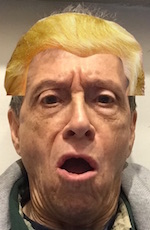
A. D. Coleman as Donald Trump, selfie, 3-16-16
Handing It to Rubio
Let me start this week’s commentary on the 2016 presidential campaign imagery with a note about Marco Rubio as the author of a powerful image.
Yes, I know, Rubio’s long since out of the race, pretty much dead in the water, and that a loss of his current bid for a second Senate term would likely end his political career. Certainly Donald Trump’s sneering dismissal of him as “Little Marco” will haunt him to his grave.
But Rubio’s counterpunch, his mention of Trump’s “small hands,” has provided him with some sweet revenge. Not so much his implication that this physical feature somehow mirrored The Donald’s penis size, but simply his calling attention to the proportions of Trump’s hands and fingers.
Rubio can’t take credit for originating this, though he may not have known of Graydon Carter’s 1980s reference to Trump as a “short-fingered vulgarian.” For Carter’s bemused account of this occasion, and Trump’s subsequent reactions thereto over the years, click here. However much that got Trump’s goat, as Carter tells it (and said goat is a cheap date), the observation didn’t — forgive me — have legs.
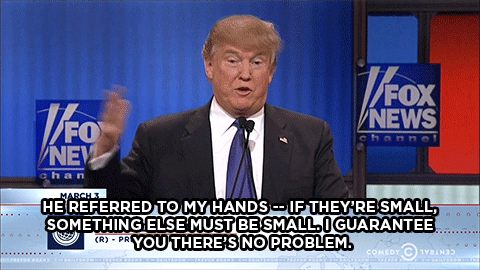 But Rubio’s version does. It has become a trope and a meme, appearing in op-eds and commentaries like this one from Robert Schlesinger, Managing Editor of U.S. News & World Report (which ends, “After all, do you want Trump’s very small fingers anywhere the nuclear button?”), sometimes inspiring entire pictorial features, such as this one in Vanity Fair. Googling “donald trump small hands” brings up 1,280,000 results, many of them full articles on the subject. Jon Gabriel’s August 13 op-ed column for AZCentral (website of the Arizona Republic, a USA Today subsidiary), “After Trump, can the Republican Party be rebuilt?” includes this:
But Rubio’s version does. It has become a trope and a meme, appearing in op-eds and commentaries like this one from Robert Schlesinger, Managing Editor of U.S. News & World Report (which ends, “After all, do you want Trump’s very small fingers anywhere the nuclear button?”), sometimes inspiring entire pictorial features, such as this one in Vanity Fair. Googling “donald trump small hands” brings up 1,280,000 results, many of them full articles on the subject. Jon Gabriel’s August 13 op-ed column for AZCentral (website of the Arizona Republic, a USA Today subsidiary), “After Trump, can the Republican Party be rebuilt?” includes this:
“Trumpism isn’t a case of free-market ‘creative destruction.’ It’s just nihilism with nothing to take its place except a dyed comb-over, a fake tan and tiny hands.”
From a visual standpoint, this wouldn’t matter so much if Trump kept his hands in his pockets, or at his sides, or on the podium. But Trump gestures continuously with his hands. So, once that thought gets planted in your head, you can’t help but look at Trump’s hands and notice his finger gestures. And yes, by contrast to his otherwise hefty physique, his hands and fingers do look … wee.
I doubt that I’d find myself noticing this if Rubio hadn’t brought it up. Since then, anytime I watch Trump speak or see photos of him, a portion of my visual attention goes to those diminutive appendages. And I’m surely not alone. In retrospect, this may prove itself Rubio’s most notable political legacy.
Losing Face
Setting politics aside, let us simply consider the next presidential administration — whichever way it goes — as a one-term (and potentially two-term) visual and auditory experience. By this I mean simply that, among other things, in electing our presidents we commit ourselves to looking at still images of them and watching and listening to videos of them speaking daily, for a minimum of four years and quite possibly eight years.
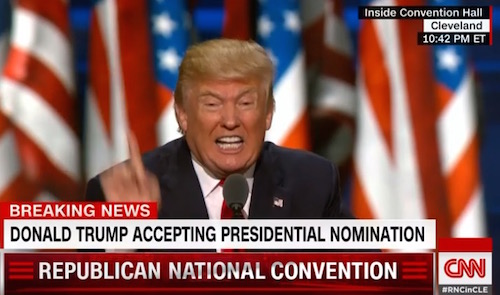
Donald Trump, Republican National Convention, 7-21-16, screenshot
Does this fact play any significant role in the elections? I have found no discussion of it anywhere, which suggests that it represents an unexamined factor in electoral politics. Perhaps for good reason — such as irrelevancy. But it simply may not have come into play before this election cycle. I can’t think of a single presidential candidate in my lifetime of political awareness (the past 60 years, roughly) who, in terms strictly of visual and vocal personality, has rubbed so many people the wrong way as has Donald Trump.
Even Richard Nixon, whom I among many considered loathsome, struck most of us that way not due to his appearance or manner of speech but as a consequence of his politics and his character. His jowls and four-o’clock shadow may have given him a sinister cast that cost him points in the 1960 debates with JFK, but they didn’t get in the way of his election in ’68 and re-election in ’72.
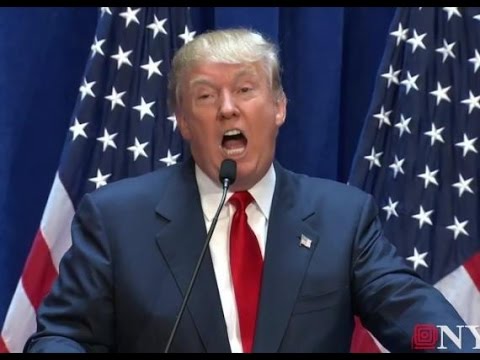
Donald Trump, 2015, screenshot
The prospect of looking at and listening to Trump for four years (or, heaven forfend, eight) actually horrifies me. His very appearance — ridiculous hairdo, ugly facial expressions, stilted body language — evokes from me a visceral revulsion. As he has become more and more a media presence since he announced his candidacy 14 months ago, he has steadily worn away whatever minimal tolerance I ever had for his relentless bullying and bluster. I simply cannot imagine a world in which matters of national and international importance to which I feel obligated to pay attention would require me to heed this megalomaniac and take his pronouncements seriously. It’s a genuinely frightening thought.
I doubt that this response to Trump makes me unique. Does this carry any weight in the campaign, among the populace at large? I think it must, yet we have no measure for it. De facto, as a campaign progresses each candidate crafts and projects a public image of him- or herself. By definition, that image has a powerful visual component. Yet far more commentary addresses the auditory aspect of their self-presentation than its visual elements.
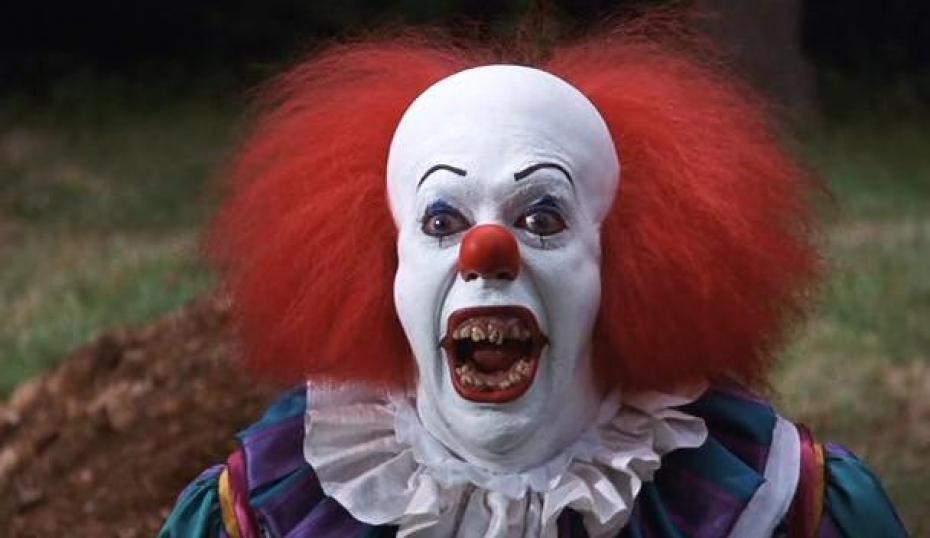
Tim Curry as Pennywise, “It” (1990), screenshot
Presumably this gets folded into the category of “popularity” and/or “likeability,” which I don’t consider insignificant but perceive as broad to the point of vaporousness. I don’t argue with the polls showing that 59 percent of Americans hold an “unfavorable” opinion of Hillary Clinton and 60 percent feel that way about Donald Trump. But surely there’s a major difference between viewing Clinton as self-serving, duplicitous, untrustworthy and finding oneself unable to stand the sight of Trump, the sound of his voice, his vocabulary, and the rhythm of his speech patterns.
For all the professed concern with the “optics” of the election cycle, no poll asks its cross-section which candidate has greater visual appeal, or which one they would prefer to watch and listen to for 48 solid months. Maybe you can’t quantify this element of the process, but that shouldn’t prevent us from discussing it.
End of the Teflon Don?
While I found the July 28 speech by Muslim-American lawyer Khizr Khan at the Democratic National Convention riveting, I did not foresee that the video of that moment, and still images thereof, would become the most powerful and durable visual documents of the convention.
Part of the credit for that goes, of course, to Khan’s emotion-charged yet measured delivery of his indictment of Donald Trump. But, just as certainly, we can chalk part of it up to Trump’s nasty, hysterical response, and his injured-innocence posture in the immediate aftermath. Had Trump simply said nothing, or something to the effect that he was sorry for their loss and grateful for their sacrifice and their son’s, the world would have moved on after one or two news cycles.
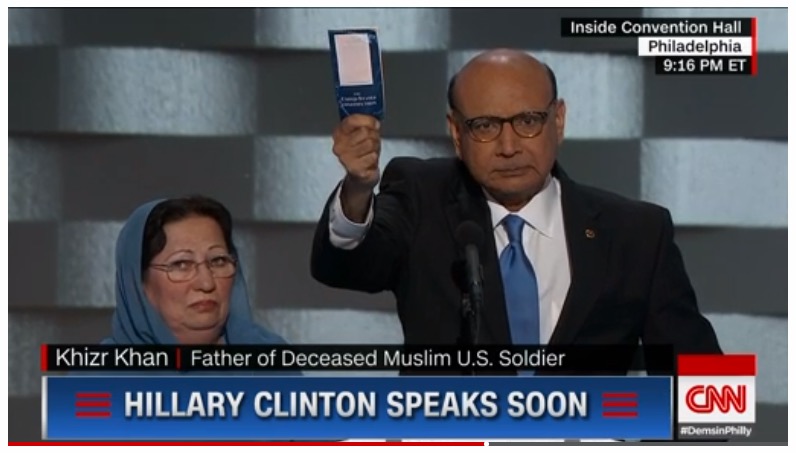
Khizr and Ghazala Khan, DNC, 7-28-16, screenshot
I think it fair to say that, if Trump loses in November, historians will look at the Khan speech as the very moment at which the collapse of The Donald’s campaign began. Because, unlike almost every other bit of ugly truth about Trump, this one didn’t slide off; it stuck, in part because Trump grappled it to him. This may signal the end of the Teflon Don — brought down, ironically, by a person of the Muslim faith. In which case Trump has no one but himself to blame.
•

Eugene Richards, “War is Personal” (2010), cover
A curious photo-historical footnote to the Khizr Khan moment in this election cycle: “In 2007 I was in Arlington National Cemetery [the US military cemetery] with my wife, Janine Altongy, to take photographs for my book War Is Personal, about Americans affected by war,” writes the distinguished American photojournalist Eugene Richards. He’d come there to photograph two women, one who’d lost her father and the other her son, both in Afghanistan.
While there, by accident, he met and photographed an American Muslim father mourning his son. You can read his account of that experience, and see the photograph that resulted, here: “Khizr Khan mourning at Arlington cemetery – the story behind the picture.”
•
(For an index of links to all posts in this series, click here.)
•
 Special offer: If you want me to either continue pursuing a particular subject or give you a break and (for one post) write on a topic — my choice — other than the current main story, make a donation of $50 via the PayPal widget below, indicating your preference in a note accompanying your donation. I’ll credit you as that new post’s sponsor, and link to a website of your choosing. Include a note with your snail-mail address (or email it to me separately) for a free signed copy of my 1995 book Critical Focus!
Special offer: If you want me to either continue pursuing a particular subject or give you a break and (for one post) write on a topic — my choice — other than the current main story, make a donation of $50 via the PayPal widget below, indicating your preference in a note accompanying your donation. I’ll credit you as that new post’s sponsor, and link to a website of your choosing. Include a note with your snail-mail address (or email it to me separately) for a free signed copy of my 1995 book Critical Focus!
Election 2016: Image World (13)
A. D. Coleman as Donald Trump, selfie, 3-16-16
Handing It to Rubio
Let me start this week’s commentary on the 2016 presidential campaign imagery with a note about Marco Rubio as the author of a powerful image.
Yes, I know, Rubio’s long since out of the race, pretty much dead in the water, and that a loss of his current bid for a second Senate term would likely end his political career. Certainly Donald Trump’s sneering dismissal of him as “Little Marco” will haunt him to his grave.
But Rubio’s counterpunch, his mention of Trump’s “small hands,” has provided him with some sweet revenge. Not so much his implication that this physical feature somehow mirrored The Donald’s penis size, but simply his calling attention to the proportions of Trump’s hands and fingers.
Rubio can’t take credit for originating this, though he may not have known of Graydon Carter’s 1980s reference to Trump as a “short-fingered vulgarian.” For Carter’s bemused account of this occasion, and Trump’s subsequent reactions thereto over the years, click here. However much that got Trump’s goat, as Carter tells it (and said goat is a cheap date), the observation didn’t — forgive me — have legs.
“Trumpism isn’t a case of free-market ‘creative destruction.’ It’s just nihilism with nothing to take its place except a dyed comb-over, a fake tan and tiny hands.”
From a visual standpoint, this wouldn’t matter so much if Trump kept his hands in his pockets, or at his sides, or on the podium. But Trump gestures continuously with his hands. So, once that thought gets planted in your head, you can’t help but look at Trump’s hands and notice his finger gestures. And yes, by contrast to his otherwise hefty physique, his hands and fingers do look … wee.
I doubt that I’d find myself noticing this if Rubio hadn’t brought it up. Since then, anytime I watch Trump speak or see photos of him, a portion of my visual attention goes to those diminutive appendages. And I’m surely not alone. In retrospect, this may prove itself Rubio’s most notable political legacy.
Losing Face
Setting politics aside, let us simply consider the next presidential administration — whichever way it goes — as a one-term (and potentially two-term) visual and auditory experience. By this I mean simply that, among other things, in electing our presidents we commit ourselves to looking at still images of them and watching and listening to videos of them speaking daily, for a minimum of four years and quite possibly eight years.
Donald Trump, Republican National Convention, 7-21-16, screenshot
Does this fact play any significant role in the elections? I have found no discussion of it anywhere, which suggests that it represents an unexamined factor in electoral politics. Perhaps for good reason — such as irrelevancy. But it simply may not have come into play before this election cycle. I can’t think of a single presidential candidate in my lifetime of political awareness (the past 60 years, roughly) who, in terms strictly of visual and vocal personality, has rubbed so many people the wrong way as has Donald Trump.
Even Richard Nixon, whom I among many considered loathsome, struck most of us that way not due to his appearance or manner of speech but as a consequence of his politics and his character. His jowls and four-o’clock shadow may have given him a sinister cast that cost him points in the 1960 debates with JFK, but they didn’t get in the way of his election in ’68 and re-election in ’72.
Donald Trump, 2015, screenshot
The prospect of looking at and listening to Trump for four years (or, heaven forfend, eight) actually horrifies me. His very appearance — ridiculous hairdo, ugly facial expressions, stilted body language — evokes from me a visceral revulsion. As he has become more and more a media presence since he announced his candidacy 14 months ago, he has steadily worn away whatever minimal tolerance I ever had for his relentless bullying and bluster. I simply cannot imagine a world in which matters of national and international importance to which I feel obligated to pay attention would require me to heed this megalomaniac and take his pronouncements seriously. It’s a genuinely frightening thought.
I doubt that this response to Trump makes me unique. Does this carry any weight in the campaign, among the populace at large? I think it must, yet we have no measure for it. De facto, as a campaign progresses each candidate crafts and projects a public image of him- or herself. By definition, that image has a powerful visual component. Yet far more commentary addresses the auditory aspect of their self-presentation than its visual elements.
Tim Curry as Pennywise, “It” (1990), screenshot
Presumably this gets folded into the category of “popularity” and/or “likeability,” which I don’t consider insignificant but perceive as broad to the point of vaporousness. I don’t argue with the polls showing that 59 percent of Americans hold an “unfavorable” opinion of Hillary Clinton and 60 percent feel that way about Donald Trump. But surely there’s a major difference between viewing Clinton as self-serving, duplicitous, untrustworthy and finding oneself unable to stand the sight of Trump, the sound of his voice, his vocabulary, and the rhythm of his speech patterns.
For all the professed concern with the “optics” of the election cycle, no poll asks its cross-section which candidate has greater visual appeal, or which one they would prefer to watch and listen to for 48 solid months. Maybe you can’t quantify this element of the process, but that shouldn’t prevent us from discussing it.
End of the Teflon Don?
While I found the July 28 speech by Muslim-American lawyer Khizr Khan at the Democratic National Convention riveting, I did not foresee that the video of that moment, and still images thereof, would become the most powerful and durable visual documents of the convention.
Part of the credit for that goes, of course, to Khan’s emotion-charged yet measured delivery of his indictment of Donald Trump. But, just as certainly, we can chalk part of it up to Trump’s nasty, hysterical response, and his injured-innocence posture in the immediate aftermath. Had Trump simply said nothing, or something to the effect that he was sorry for their loss and grateful for their sacrifice and their son’s, the world would have moved on after one or two news cycles.
Khizr and Ghazala Khan, DNC, 7-28-16, screenshot
I think it fair to say that, if Trump loses in November, historians will look at the Khan speech as the very moment at which the collapse of The Donald’s campaign began. Because, unlike almost every other bit of ugly truth about Trump, this one didn’t slide off; it stuck, in part because Trump grappled it to him. This may signal the end of the Teflon Don — brought down, ironically, by a person of the Muslim faith. In which case Trump has no one but himself to blame.
•
Eugene Richards, “War is Personal” (2010), cover
A curious photo-historical footnote to the Khizr Khan moment in this election cycle: “In 2007 I was in Arlington National Cemetery [the US military cemetery] with my wife, Janine Altongy, to take photographs for my book War Is Personal, about Americans affected by war,” writes the distinguished American photojournalist Eugene Richards. He’d come there to photograph two women, one who’d lost her father and the other her son, both in Afghanistan.
While there, by accident, he met and photographed an American Muslim father mourning his son. You can read his account of that experience, and see the photograph that resulted, here: “Khizr Khan mourning at Arlington cemetery – the story behind the picture.”
•
(For an index of links to all posts in this series, click here.)
•